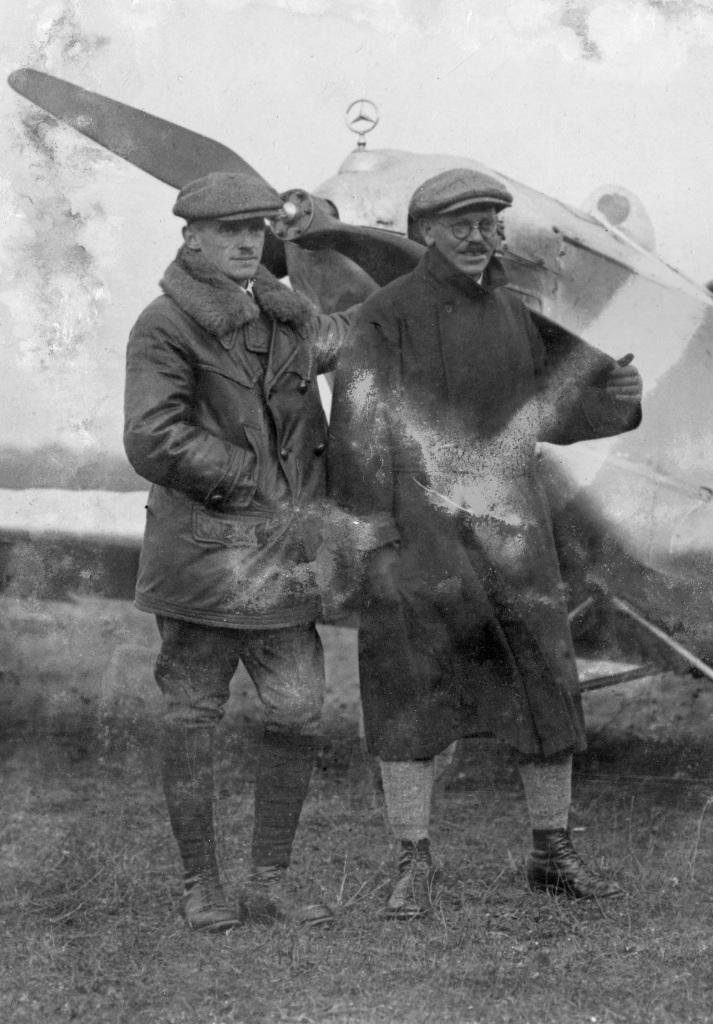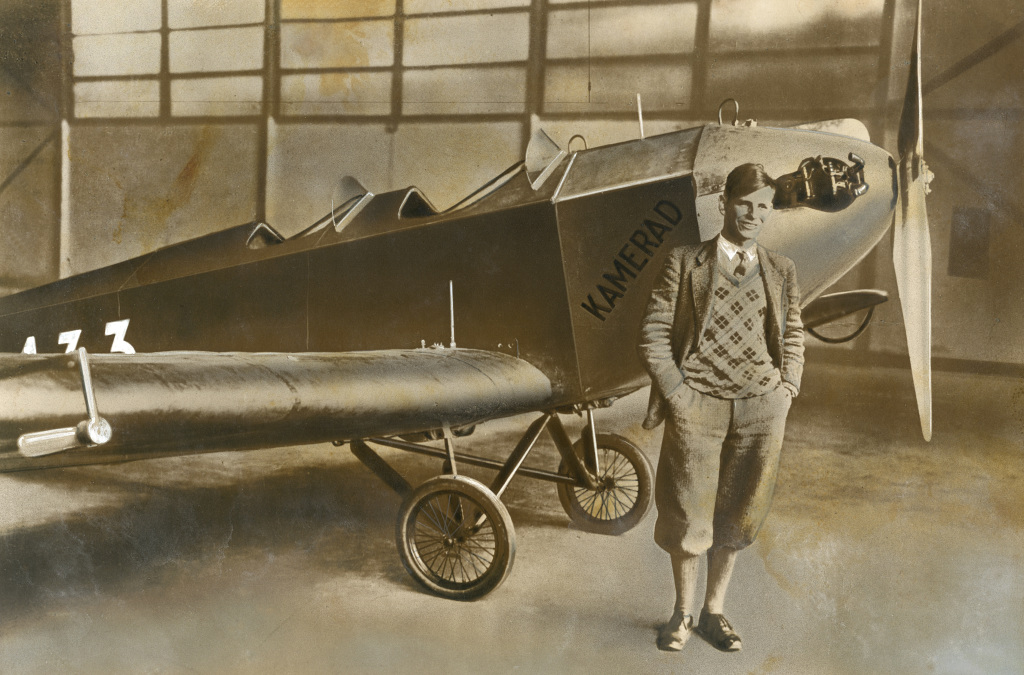
In August 1928, Friedrich Karl von Koenig-Warthausen embarks on a great adventure: He intends to fly to Moscow with his Klemm-Daimler L 20 light aircraft in record time. Once there, he spontaneously decides to fly all the way around the whole world to win the Hindenburg Trophy for long-distance flight. The monoplane is powered by a robust and reliable Mercedes-Benz F 7502 two-cylinder aircraft engine. An authentically reconstructed L 20 like the one Koenig-Warthausen flew around the world is on display in the Mercedes-Benz Museum. Today, Daimler pursues connected mobility in the air by acquiring a stake in the start-up company Volocopter, among other things.
Stuttgart. It is the early morning on 11 August 1928. Friedrich Karl Freiherr Koenig von und zu Warthausen, barely 22 years old, takes off for his record-setting flight from Berlin-Tempelhof to Moscow. He has named his Klemm-Daimler light aircraft “Kamerad”, the German word for “companion”. “I circled the airfield twice to say good-bye and gain altitude against the strong wind at the same time. After climbing two hundred metres, I fired a green flare from my flare pistol into the pitch-black sky as a last farewell for my friends. Then up and away!” – as Koenig-Warthausen later recalls this episode in his book “Mit 20 PS und Leuchtpistole” (“With 20 hp and a Flare Pistol”). The pilot intends to be away from Berlin just for a few days. Ultimately, it will be more than 15 months.

The flight first takes him over Berlin’s sea of lights to Poland. Gdansk appears in the early morning sun. Koenig-Warthausen crosses the border to the Soviet Union as planned between the villages “Bigosowo and Balbino near Dünaburg”. The strain of the long flight is growing, but the pilot keeps bearing the record attempt in mind: “I kept recalling the objective of my flight during these oppressive midday hours time and again. I had to make it to Moscow! If I was able to get there without stopping, it would be a world record. Nobody had ever flown such a distance with a lightweight engine. If I made it to Moscow, there was a good chance I would win the Hindenburg Prize with my flight, which had been established for the best German amateur with a small aircraft. Hindenburg flyer, I definitely wanted to become one.”
The yearning to fly
This “Hindenburg Trophy” was awarded by President of the German Reich Paul von Hindenburg for the first time in 1928 and comes with 10,000 Reichsmark in prize money. It would pay the cost for buying the L 20, which the parents of the flyer financed in advance: The monoplane advertised by Leichtflugzeugbau Klemm GmbH Company in Sindelfingen as an “aircraft for school, travel, sport” costs 7,250 Reichsmark in 1928.

The plane, powered by a Mercedes-Benz F 7502 aircraft engine rated at 15 kW (20 hp), arouses yearning in an era buoyed by the excitement about the transcontinental flights of Charles Lindbergh and his successors. Under the headline “Ein Volksflugzeug” (“A People’s Plane”), the “ Berliner Zeitung” newspaper reports on 12 February 1928 about the development by aviation pioneer Hanns Klemm: Light aircraft such as the L 20 with its robust and reliable Mercedes-Benz engine are considered the key to a future democratisation of aviation – similar to what is happening at the time with the automobile.

The record-setting attempt of Baron von Koenig-Warthausen goes to plan at first. However, on the afternoon of the 12 August 1928, the weather begins to deteriorate. He races above the railway tracks toward Moscow through clouds and sheets of rain. Finally, 20 minutes before reaching the Russian capital, the visibility becomes so poor that he has to land the L 20 in a field. The pilot learns the he has almost reached his destination from the mayor of the nearby village. “I had covered one thousand seven hundred kilometres in sixteen hours”, writes Koenig-Warthausen enthusiastically in his notes. “With my flight, I had far surpassed the previous distance record for light aircraft, which was held by two Frenchmen.”
However, the record is not recognised on formal grounds: The jurors do not recognise the detour required due to the way the border to the Soviet Union runs as part of the flight distance. And will the achievement be enough to win the Hindenburg Trophy? After all, there are other young flyers who are planning similar endeavours with light aircraft at that time.
With 20 hp around the world
As a result, the baron makes the second spontaneous decision within a few days: After the excellent experiences with his “ Kamerad”, he takes off for a flight around the world. The preparations are straightforward: The parents send 500 Reichsmark, the L 20 is fitted with a new propeller with a thin coating of brass sheet as protection against the weather, the pilot invests in “good tools for any potential repairs, a spare wheel and ammunition for the flare pistol […]. Then I went and bought maps of southern Russia…”.
This is how one of the greatest adventures in the history of the light aircraft from Hanns Klemm starts to pick up steam. Aviation pioneer Klemm is born in Stuttgart in 1885 – one year before the invention of the automobile by Carl Benz – and, after completing his secondary education, studies civil engineering at the technical university in his home town. He soon switches from building bridges and buildings to aviation: He becomes the director of prototyping in the Dornier division of Luftschiffbau Zeppelin Company in Friedrichshafen still during the First World War. A stop at Heinkel follows.
In April 1918, Klemm finally becomes chief designer of aircraft construction of what was then Daimler-Motoren-Gesellschaft (DMG). The first proprietary designs such as the Daimler L 11 and L 14 fighter and reconnaissance aircraft already emerge during this time. However, the designs never go into production, because the 1919 Treaty of Versailles prohibits Germany from buying or importing aircraft and their parts. Klemm thus takes over the job of technical director at the Daimler plant in Sindelfingen.
However, the engineer keeps working on his dream of an “ aeroplane for everyone”. It starts with the Daimler L 15 in 1919. The breakthrough finally comes with the L 20 light aircraft.
Klemm ventures into self-employment after Daimler-Benz AG focuses on building vehicles and suspends aircraft production. His company sets up shop in Sindelfingen in 1926. The Stuttgart-Böblingen regional airport is the immediate neighbour at the time. In a brochure published in 1929, the company explains the positioning of its products in the contemporary market for aircraft as follows: “True, there are excellent aircraft for military uses and we have those for aerobatics and air races, we have flying buses and express services with maximum performance – but the general public so far lacked the simple, cheap, easy-to-fly and handle individual means of air travel”. Klemm intends to close this gap with the L 20, which is equipped with the “matching 20-hp lightweight aircraft engine by Dr Ing Ferdinand Porsche, director and chief constructor of Daimler-Motoren-Gesellschaft”. However, at the time the brochure is published, Porsche has already resigned from Daimler-Benz AG created in 1926 by the merger of DMG and Benz & Cie. The pilots flying Klemm aircraft also include celebrities such as Ernst Udet and Elly Beinhorn, who would become the wife of Auto-Union racing driver Bernd Rosemeyer.

With a lightweight to 6,700 metres
The F 7502 air-cooled aircraft engine weighs 48 kilograms. It has two horizontally opposed cylinders with a total displacement of 884 cubic centimetres (75 millimetre bore x 100 millimetre stroke) and produces 15 kW (20 hp) at 3,000 rpm. A three-speed reduction gear ensures the propeller in the L 20 spins at 1,000 rpm.
The engine follows a long and successful tradition of aircraft engines from Daimler-Benz AG and its originating companies. They were continuously advanced since the first powered flight of the airship of Dr Friedrich Hermann Wölfert on 10 August 1888. Back then 130 year ago, a 1.8-kW (2.5-hp) Daimler one-cylinder engine powers Wölfert’s machine. The large Mercedes-Benz V12 aircraft engines in the late 1930s produce nearly 2,059 kW (2,800 hp).
The F 7502 proves to be the perfect engine for the Klemm-Daimler light aircraft. With it, the L 20 reaches speeds of up to 125 km/h in level flight, climbs to an altitude of 1,000 metres in eight minutes without passengers and reaches a service ceiling of 6,700 metres (likewise without passengers). For missions such as the baron’s flight around the world, it is its exceptionally high versatility that is important: The monoplane with a length of 7.30 metres and a wingspan of 13 metres can be folded to transport dimensions of 6.50 x 1.50 x 2.20 metres in just eight minutes. The aeroplane can then be housed “in a barn or garage or hooked up to a small car to be taken to the next place”, the advertising brochure reads. In addition, when landing away from paved runways, the aeroplane impresses with its low centre of gravity that is just one metre above the ground, and the fixed landing gear without continuous axle.
Friedrich Karl von Koenig-Warthausen takes off in his L 20 from Moscow towards the Orient. He witnesses airfields without hangars or sheds, flies over old fortified towns and the expanses of the Caucasus, over camel trains and giant oil fields with an entire forest of drilling derricks. During a stop in Baku, the baron finally plans to continue to “the fairytale city Tehran” in Persia. During his stays, he gets to know the people in these far away lands. And the young German flyer finds a warm welcome and help nearly everywhere. The French-language Persian newspaper “ Tehran Herald” poetically calls Koenig-Warthausen “a shining star that came down from the sky like a comet”. Even more important to the pilot is probably that he won the 1928 Hindenburg Trophy with his flight to Tehran – he has accomplished his personal goal.

Homeward across oceans and continents
The next legs of the flight take Koenig-Warthausen across Asia. Magical town names start accumulating in the neatly kept log of the L 20, stamped by official authorities wherever possible. In it, the pilot keeps track of every take-off: Among them are Isfahan, Karachi, Jodhpur, Agra and finally Bangkok and Singapore. He continues to Japan by ship and after a few legs of flight from there on to North America. The L 20 crosses the United States from San Francisco to New York, with a small detour to Canada. The German pilot is repeatedly hailed for his accomplishment. On 9 July 1929, the “Tucson Star” writes about the spectacular flight around the world under the headline “Cycle Plane Brings Baron”.
Baron von Koenig-Warthausen misses winning the second Hindenburg Trophy in a row by a hair: He arrives at the Roosevelt Field airfield in New York on 3 November 1929, two days too late for another award. However, nobody can take the triumph of this exceptional flight around the world with 15 kW (20 hp) away from him. The masterpiece is accomplished equally through the performance of the pilot, the loyal and reliable L 20, and the support of people along the route of flight. The “Neue Zeitung Berlin” newspaper writes on 20 November 1929: “The flight had to succeed, not only because the engine was good, not only because the young flyer found the sporting help everywhere in the most far away foreign countries, which his home unfortunately denied him in part […], no: at the yoke of his Hünefeld was a real man, a man who knew exactly what he wanted and who flew with an idea in his mind and in his heart”. The name “Hünefeld” in the article referred to the new name of his L 20, which Koenig-Warthausen picked after his arrival in the USA to honour the record-setting pilot Ehrenfried Günther Freiherr von Hünefeld, participant of the east-to-west flight across the North Atlantic in 1928.
After the ship passage, Koenig-Warthausen takes off from Bremerhaven for the last leg of his flight around the world on 22 November 1929. However, due to poor weather, he ends the flight in Bevensen (Lower Saxony) with an emergency landing. “End of the flight Berlin – Asia – USA – Berlin” is what the baron enters in his log the next day. The Klemm-Daimler L 20 light aircraft is returned to airworthy condition in Bevensen and transferred to the factory of the manufacturer on 28 November 1929.
Replica of the record-setting aircraft in the Mercedes-Benz Museum
The Klemm-Daimler L 20 light aircraft “Kamerad” has been part of the permanent exhibition of the Mercedes-Benz Museum in Stuttgart since 1980. Because the original aircraft of Baron von Koenig-Warthausen no longer exists, a detailed replica based on an L 20 is built specifically for the museum. The baron personally makes a host of documents from the private archives of the Koenig-Warthausen family available for this purpose. Today, the L 20 is part of the “Legends Room 3: Upheavals – Diesel and Compressor” and there soars over the visitors. The dream of the personal aircraft as a means of daily transport is given a strong boost by accomplishments such as the flight around the world 90 years ago with the Mercedes-Benz aircraft engine. This vision has not caught on to date. But that could change in the years to come – for example, due to the aviation start-up Volocopter from Bruchsal. The company intends to launch autonomous electric air taxis (eVTOL) in a few years. Daimler AG holds a stake in Volocopter.






